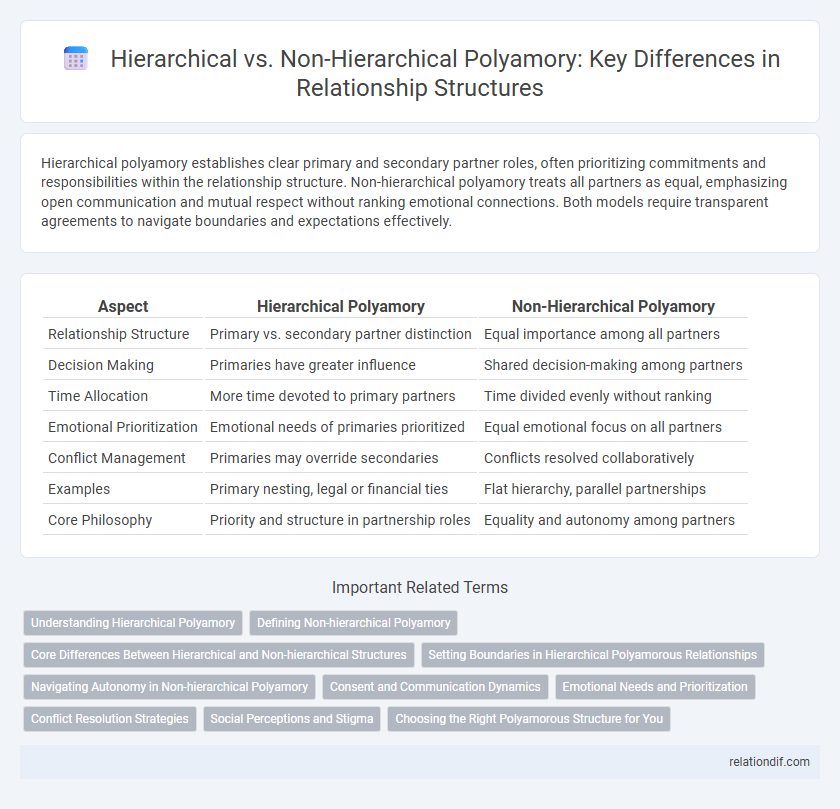Hierarchical polyamory establishes clear primary and secondary partner roles, often prioritizing commitments and responsibilities within the relationship structure. Non-hierarchical polyamory treats all partners as equal, emphasizing open communication and mutual respect without ranking emotional connections. Both models require transparent agreements to navigate boundaries and expectations effectively.
Table of Comparison
| Aspect | Hierarchical Polyamory | Non-Hierarchical Polyamory |
|---|---|---|
| Relationship Structure | Primary vs. secondary partner distinction | Equal importance among all partners |
| Decision Making | Primaries have greater influence | Shared decision-making among partners |
| Time Allocation | More time devoted to primary partners | Time divided evenly without ranking |
| Emotional Prioritization | Emotional needs of primaries prioritized | Equal emotional focus on all partners |
| Conflict Management | Primaries may override secondaries | Conflicts resolved collaboratively |
| Examples | Primary nesting, legal or financial ties | Flat hierarchy, parallel partnerships |
| Core Philosophy | Priority and structure in partnership roles | Equality and autonomy among partners |
Understanding Hierarchical Polyamory
Hierarchical polyamory organizes relationships by assigning primary, secondary, and tertiary statuses, prioritizing certain partners over others. Primary partnerships often involve shared responsibilities such as financial obligations, cohabitation, or parenting, creating structured boundaries to maintain clarity and stability. Understanding hierarchical polyamory requires recognizing its emphasis on clear commitments and negotiated agreements to balance multiple intimate connections.
Defining Non-hierarchical Polyamory
Non-hierarchical polyamory involves equal prioritization and emotional value assigned to all partners without establishing primary or secondary roles. This model fosters open communication, mutual respect, and autonomy, promoting flexibility in relationship dynamics. Partners share responsibilities and decision-making, emphasizing consensual agreements over rigid structures.
Core Differences Between Hierarchical and Non-hierarchical Structures
Hierarchical polyamory structures prioritize primary relationships with established rules about time, emotional investment, and decision-making authority, often granting primacy to one partner over others. Non-hierarchical polyamory emphasizes equal value among partners, promoting autonomy and fluid negotiation without ranked commitments. These core differences affect relationship dynamics, boundaries, and communication strategies within polyamorous networks.
Setting Boundaries in Hierarchical Polyamorous Relationships
Setting boundaries in hierarchical polyamorous relationships involves clearly defining primary and secondary partnership roles to manage emotional needs and time allocation effectively. Establishing agreements about communication, mutual respect, and decision-making authority helps prevent misunderstandings and nurtures trust among all partners. Clearly articulated expectations support relationship stability and promote equitable consideration despite differing degrees of commitment.
Navigating Autonomy in Non-hierarchical Polyamory
Navigating autonomy in non-hierarchical polyamory involves balancing personal freedom with mutual respect among partners, ensuring no relationship is privileged over another. Effective communication and boundary-setting are essential to support individual independence while maintaining connection and trust within the partnership network. This approach fosters equal partnership dynamics and promotes emotional honesty without imposed hierarchies.
Consent and Communication Dynamics
Hierarchical polyamory involves predefined roles and prioritized relationships, requiring explicit consent and structured communication to navigate power dynamics effectively. Non-hierarchical polyamory emphasizes equal importance among partners, relying on ongoing, transparent dialogue to maintain mutual consent and address evolving emotional needs. Both models depend on clear, honest communication to foster trust and respect within diverse relational agreements.
Emotional Needs and Prioritization
Hierarchical polyamory involves prioritizing primary partners' emotional needs, often granting them greater time and decision-making power, which can create structured support but may inadvertently neglect secondary partners. Non-hierarchical polyamory treats all partners as equals, emphasizing balanced emotional investment and mutual prioritization to ensure no partner feels undervalued. Both models require clear communication and consent to navigate emotional boundaries and maintain healthy relationships.
Conflict Resolution Strategies
Hierarchical polyamory uses clearly defined roles and primary/secondary partner distinctions to guide conflict resolution, often prioritizing the needs of the primary relationship. Non-hierarchical polyamory promotes equal partner status and collaborative decision-making, encouraging direct communication and mutual respect to resolve conflicts without predefined power structures. Effective conflict resolution in both models relies on transparency, negotiation skills, and consistent emotional validation to maintain healthy partnerships.
Social Perceptions and Stigma
Hierarchical polyamory often faces social stigma due to its structured relationship priorities, which many perceive as reinforcing traditional monogamous norms. Non-hierarchical polyamory challenges these norms by promoting equality among partners, yet it encounters skepticism for its unconventional approach to commitment. Public perceptions of both models are influenced by cultural biases, with hierarchical systems sometimes regarded as more socially acceptable despite both experiencing significant misunderstanding.
Choosing the Right Polyamorous Structure for You
Choosing the right polyamorous structure depends on individual needs and relationship goals, with hierarchical polyamory offering clear prioritization among partners, often designating primary and secondary relationships. Non-hierarchical polyamory emphasizes equality and fluidity, where all partners share similar levels of commitment and involvement without ranked distinctions. Understanding emotional boundaries, communication styles, and time management preferences helps determine which structure best supports personal well-being and relational harmony.
Hierarchical vs Non-hierarchical polyamory Infographic

 relationdif.com
relationdif.com